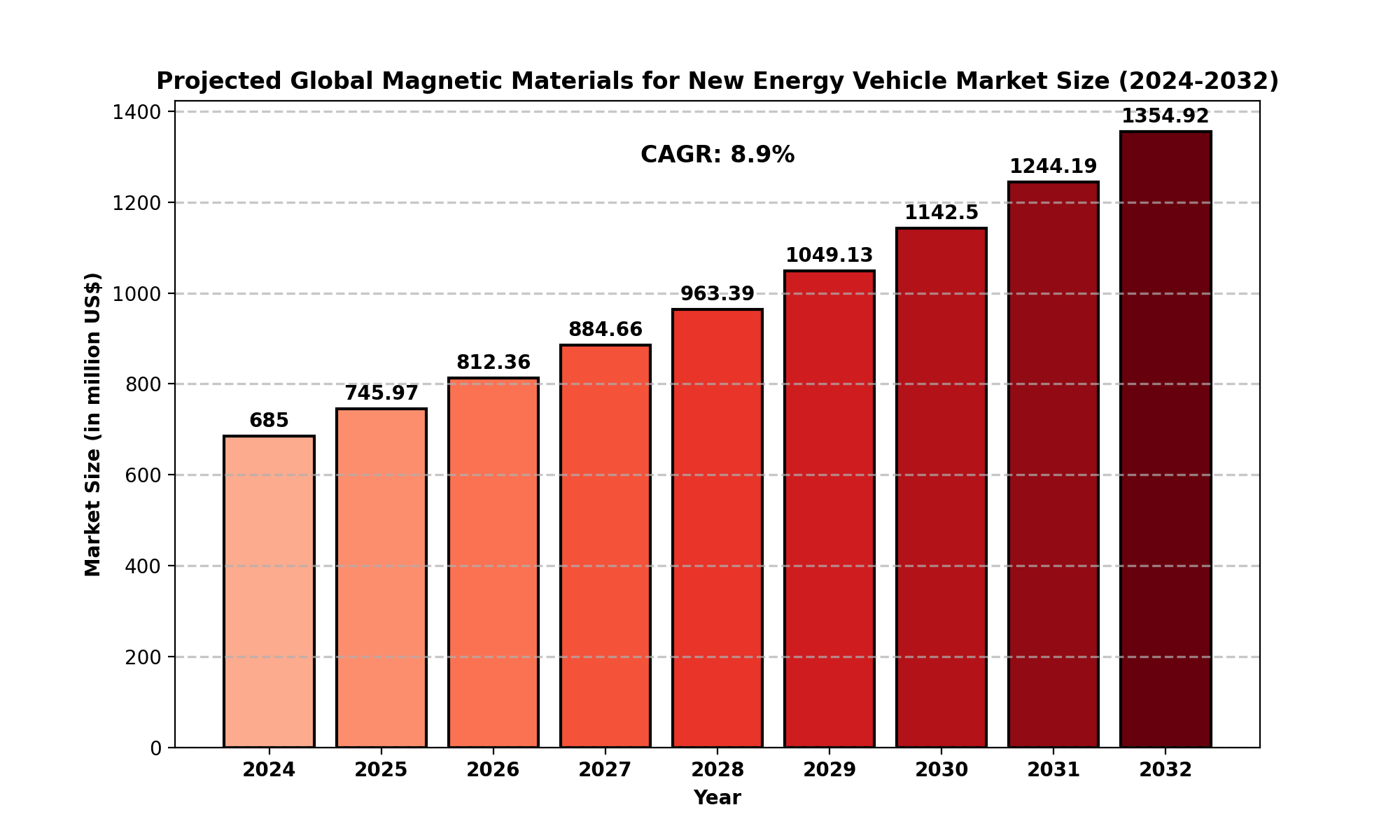TOP CATEGORY: Chemicals & Materials | Life Sciences | Banking & Finance | ICT Media
The global Magnetic Materials for New Energy Vehicle market refers to the production and utilization of magnetic materials such as permanent and soft magnetic materials in the development of components used in new energy vehicles (NEVs). These materials, including hard ferrites, alnico, samarium cobalt, and neodymium iron boron, play a critical role in the performance and efficiency of NEVs by facilitating essential functions like energy conversion, electric motor operation, and sensor responsiveness. Hard ferrites are particularly prominent due to their affordability and wide availability.
The global Magnetic Materials for New Energy Vehicle market is valued at an estimated USD 685 millionin 2024. Projections indicate substantial growth, with the market expected to reach USD 1,354.92 million by 2032, registering a CAGR of 8.90% over the forecast period.
This growth is driven by the escalating demand for NEVs fueled by environmental concerns, government incentives, and advancements in electric mobility technologies.
In North America, the market size stands at USD 206.76 million in 2024, with a projected CAGR of 7.63% from 2025 to 2032, highlighting the region's growing adoption of sustainable transportation solutions.

Rising NEV Adoption: The global shift towards sustainable and eco-friendly transportation solutions is a major growth driver. Governments worldwide are introducing incentives, subsidies, and regulatory frameworks to encourage the adoption of NEVs.
Technological Advancements: Innovations in magnetic material production, such as the development of high-performance neodymium iron boron magnets, enhance motor efficiency and reduce energy loss.
Energy Efficiency Demand: Increasing demand for energy-efficient vehicles is propelling the market for advanced magnetic materials, which are integral to improving vehicle performance.
High Cost of Advanced Materials: Premium magnetic materials such as samarium cobalt and neodymium iron boron are expensive, which can restrict their adoption, especially in cost-sensitive markets.
Supply Chain Disruptions: Dependence on specific regions for raw material extraction, such as rare earth elements, exposes the market to geopolitical and supply chain risks.
Emerging Markets: Rapid urbanization and rising income levels in developing countries create opportunities for NEV adoption and, consequently, magnetic materials.
R&D Investments: Increased investments in research and development can lead to cost-effective and environmentally sustainable magnetic material alternatives.
Recycling and Sustainability: Developing efficient recycling processes for rare earth materials remains a significant challenge.
Competition from Alternative Technologies: The emergence of alternative propulsion technologies may impact the demand for magnetic materials in NEVs.
The North American market, valued at USD 206.76 million in 2024, is characterized by a robust regulatory framework supporting NEV adoption and significant investments in electric vehicle (EV) infrastructure.
Europe is a key region due to stringent emission regulations and the presence of prominent automobile manufacturers transitioning to electric mobility. Countries like Germany, France, and the UK drive market growth.
Asia-Pacific dominates the market, with China leading in NEV production and consumption. Favorable government policies, coupled with a strong manufacturing base, position the region as a global hub.
The South American market shows steady growth, with countries like Brazil and Argentina exploring sustainable mobility solutions to reduce dependency on fossil fuels.
Although the adoption of NEVs in the Middle East and Africa is relatively nascent, increasing awareness and government initiatives are fostering gradual growth in this region.
Key players in the global Magnetic Materials for New Energy Vehicle market include:
Hitachi Metals Group: A leader in advanced magnetic materials and components.
TDK: Renowned for its innovations in magnetic solutions and electronics.
Zhong Ke San Huan Hi-Tech: Specializes in high-performance rare earth magnets.
DMEGC Magnetics: Focuses on a diverse range of magnetic material applications.
JPMF: A prominent supplier of magnetic solutions.
Ningbo Yunsheng: Known for producing neodymium magnets.
AT&M: Delivers high-quality magnetic materials for various industrial applications.
Shin-Etsu: A global supplier of rare earth magnets.
Zhenghai Magnetic Material: Provides cutting-edge magnetic solutions for the automotive sector.
Passenger Vehicle: Magnetic materials are extensively used in electric motors, sensors, and regenerative braking systems.
Commercial Vehicle: Demand is driven by the electrification of logistics and public transportation fleets.
Permanent Magnetic Materials: These materials, including hard ferrites and neodymium iron boron, are crucial for permanent magnet motors.
Soft Magnetic Materials: Primarily used in transformers and inductors to enhance energy efficiency.
North America: USA, Canada, Mexico
Europe: Germany, UK, France, Russia, Italy, Rest of Europe
Asia-Pacific: China, Japan, South Korea, India, Southeast Asia, Rest of Asia-Pacific
South America: Brazil, Argentina, Columbia, Rest of South America
Middle East and Africa: Saudi Arabia, UAE, Egypt, Nigeria, South Africa, Rest of MEA
What is the current market size of the Magnetic Materials for New Energy Vehicle market?
Which are the key companies operating in the Magnetic Materials for New Energy Vehicle market?
What are the key growth drivers in the Magnetic Materials for New Energy Vehicle market?
Which regions dominate the Magnetic Materials for New Energy Vehicle market?
What are the emerging trends in the Magnetic Materials for New Energy Vehicle market?
Key Benefits of This Market Research:
Key Reasons to Buy this Report: